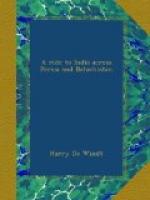There is probably no peasantry in the world so ground down and oppressed as the Persian. The agricultural labourer never tries to ameliorate his condition, or save up money for his old age, for the simple reason that, on becoming known to the rulers of the land, it is at once taken away from him. Though poor, however (so far as cash and valuables are concerned), the general condition of the labouring classes is not so bad as might be supposed. In a country so vast (550,000 square miles) and so thinly populated (5,000,000 in all), a small and sufficient supply of food is easily raised, especially with such prolific soil at the command of the poorest. At Shiraz, for instance, there are two harvests in the year. The seifi, sown in summer and reaped in autumn, consists of rice, cotton, Indian corn, and garden produce; the tchatvi, sown in October and November, and reaped from May till July, is exclusively wheat and barley. A quantity of fruit is also grown—grapes, oranges, and pomegranates. Shiraz is famed for the latter. The heat and dust, to say nothing of smells, prevented me from often entering the city; but I walked through the bazaar once or twice, and succeeded in purchasing some old tapestries and a prayer-carpet. The merchants here are not so reserved and secretive as those of Teheran and other cities, and are, moreover, civil enough to produce coffee and a kalyan at the conclusion of a bargain, as at Stamboul. The best tobacco for kalyan-smoking is grown round Shiraz. Some, the coarser kind, from Kazeroon and Zulfaicar, is exported to Turkey and Egypt, but the most delicate Shiraz never leaves the country. The pipe is on the same principle as the narghileh, the smoke being drawn through a vessel of water. The tube, a wooden stalk about two feet long, is changed when it becomes tainted with use; for the people of the East (unlike some in the West) like their tobacco clean.
Manufactories are trifling in comparison with what they were in former days. Where, a century since, there stood five hundred factories owned by weavers, there are now only ten, for the supply of a coarse white cotton material called “kerbas,” and carpets of a cheap and common kind. Earthenware and glass is also made in small quantities, the latter only for wine-bottles and kalyan water-bowls. All the best glass is imported from Russia. A kind of mosaic work called “khatemi,”




